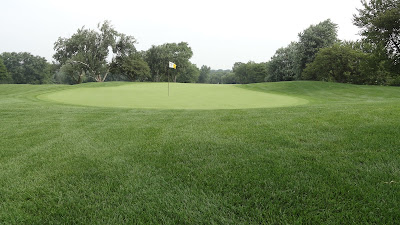The following article recently appeared in the USGA Green Section Record. It was written by Ty McClellan. Ty is our USGA regional agronomist. We utilize his expertise on a regular basis; he visits Naperville CC regularly to evaluate course conditions. This is part of a program offered through the USGA Turfgrass Advisory Service. The article is very timely so I wanted to pass it along.
By Ty McClellan, agronomist, Mid-Continent Region
July 13, 2011
 | |  |
Randomly scattered divots (on the left) remove up to 50% more turf than practicing in a linear pattern (on the right) where each new shot is placed directly behind the previous divot.
|
Late July is usually the time when there is a lack of turf coverage on practice range tees established with cool-season turfgrasses, such as creeping bentgrass or Kentucky bluegrass. Heavy play removes divots faster than the turf can recover, and hot, dry summer conditions leave little opportunity for seedling establishment or regenerative growth of surrounding turf. Poor turf coverage that comes in mid-summer generally indicates that the practice tee is simply undersized for the amount of play received, i.e. there is not enough time for turf to recover before tee stalls are returned to previous locations. It also indicates that tee stall rotations need to be reviewed for efficiency and that synthetic turf options should be considered at the rear of the tee to provide the additional time needed for turf recovery.
With the exception of an efficient tee stall rotation, enlarging the tee(s) and adding synthetic turf are improvements typically left for the off-season when time and funds become available. So, until then, what can be done? The solution resides with golfers. Since randomly scattering divots can quickly destroy a practice range tee, the better approach is to shrink one’s divots by removing them in a pattern just like the professionals. More specifically, this includes placing each shot directly behind the previous divot. This can easily be repeated for up to 10 shots resulting in much less turf being removed.
Let’s take a look at a practical example that was provided by Golf Course Superintendent Chris Pekarek at The Village Links of Glen Ellyn in Illinois. Mr. Pekarek estimates more than 2 million shots are taken annually from the 1.25-acre Kentucky bluegrass practice tee and that 1.5 million of the shots result in turf removal. Although divots come in all sizes, the average iron shot is believed to remove a divot 3 inches wide by 6.5 inches long for a total of 19.5 square inches. After just 30 shots, or a small bucket of balls, 4.1 square feet of turf are removed, given a typical practice routine (30 shots x 19.5 in2 = 585 in2 / 144 in2 = 4.1 ft2). Therefore, after an entire season, 205,000 square feet of divots are removed from the tee. That's more than 4.6 acres of turf from their 1.25-acre surface.
If instead each shot is played directly behind the previous divot, subsequent divots are reduced to an average size of 3 inches wide by 3 inches long, or 9 square inches. After 30 shots, this pattern removes only 2.1 square feet of turf. (As the first divot removes 19.5 square inches and the subsequent 9 divots remove 9 square inches each for a total of 81 square inches, a total of 100.5 square inches is removed for every 10 shots, which is typical for this linear pattern. For 30 shots or a small bucket of balls, 3 x 100.5 = 301.5 in2 / 144 in2 = 2.1ft2 are removed.) If everyone adopted this method, the annual number of divots removed would be reduced from 205,000 square feet to just 105,000 square feet. That’s nearly a 50% reduction in the amount of turf removed.
Implementing this simple divot pattern into your practice regime has significant season-long implications at your facility. So, rather than voice a complaint about the turf during oppressive conditions in July and August, do the turf a favor and practice like a pro!
























